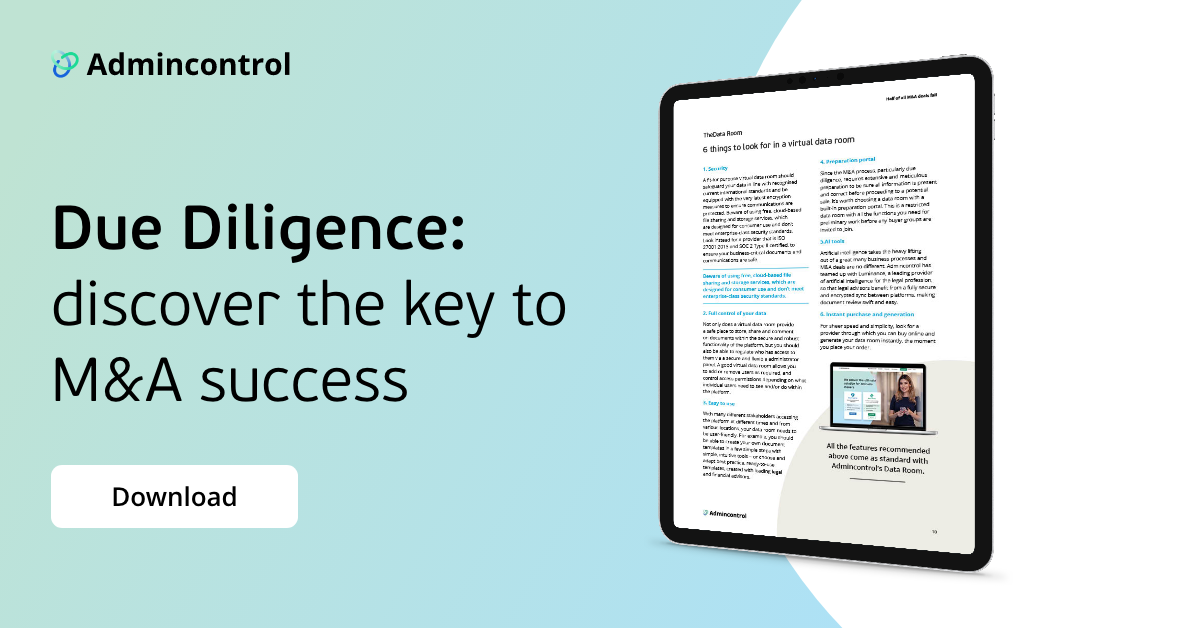There’s a saying; those that fail to plan, plan to fail, and it’s a sentiment that definitely applies when integrating two companies. The challenges of transitioning to a single and efficient entity are well documented and studies show it’s where many modern mergers & acquisitions (M&A) deals fail. From operations to people and finances to brands, a powerful strategy is essential to realising the true value of the deal.
In this guide, we look at:
- The current M&A landscape and its challenges and opportunities
- The outlook for deals in 2023 amidst geopolitical uncertainty
- Why so many deals don’t realise their true value
- The must-have elements of a powerful integration strategy
The M&A Landscape
It’s been a turbulent few years for dealmakers and the uncertainty is not over yet. Much has been written about the impact of a global pandemic followed by a record-breaking year for M&As in 2021, especially in terms of deal value. More recently the fallout from Russia’s invasion of Ukraine, soaring energy prices, and now a recession, is set to create further unpredictability.
Against this backdrop of volatility, the pattern of deal activity is harder to predict with any certainty. However, law firms such as Osborne Clarke2, argue there will be opportunities and expect private equity and cash-rich acquirers to be especially active.
The consulting firm, EY, points to overall resilience3 highlighting that although cross-border deals are down, in response to the current geopolitical situation, tech deals are currently at double the average for the 2015-19 period.
Predictions for 2023
- 73% of dealmakers expect European M&A to increase over the next 12 months, compared to 53% in 2021
- 87% of dealmakers believe financing deals will be harder compared to 2021
- 90% of dealmakers expect the focus on environmental, social and governance (ESG) factors to increase over the next three years, versus 72% in 2021
Source: European M&A Outlook 2023 - CMS & Mergermarket
Who’s looking to buy and sell in 2023?
Sectors including technology, fintech, communications and biotech are expected to be amongst the most active acquirers2, while retail and service industries are more likely to be in a period of consolidation as they embed changes they made in response to the pandemic.
Perhaps more surprisingly, however, oil and oil related services are expected to rally, especially in the Nordic region. Tax and legal specialists at CMS point to a more vibrant end to 2022 for the energy sector in Norway for example, a trend that appears to be a direct result of the squeeze on gas supplies from Russia4.
M&As in 2022
Nordic region
Deal volume down by 11%, deal value up by 7%
Whole of Europe
Deal volume down by 8%, deal value up by 1%
Source: European M&A Outlook 2023 - CMS & Mergermarket
Inevitably, as economic conditions bite, there will be consolidation and failure of businesses across many sectors so distressed acquisitions will likely take a bigger share of overall M&A activity. In a similar vein, many businesses will be seeking to consolidate their operations after a tough few years, perhaps divesting underperforming divisions that were hit hard by the effects of the pandemic, or streamlining operations as hybrid working embeds into their permanent culture.
The energy sector has also been lively. The trend towards renewables deals is cooling off a little, while oil and oil services deals are recovering amidst the current geopolitical climate.4
Deals will take longer
Whilst the level of activity might be harder to predict over the next 12 months, other trends are easier to spot. Osborne Clarke points to extended periods of due diligence2 reflecting the more complicated factors that exist, particularly in relation to cross-border deals. They believe all deals will take longer and negotiations will become more complex.
In turn, this will fuel the continued use of technology in M&As, artificial intelligence (AI) and other digital tools to increase efficiency and lessen the administrative burden on dealmakers, such as:
“Digitalisation of processes, including e-filings, e-signings, artificial intelligence and automated processes for due diligence, automation of agreements, drones for site visits, digital payment platforms, consideration settled with crypto assets and the potential use of smart contracts for escrow and other simpler payment obligations.”
Osborne Clarke
M&A tools, such as virtual data rooms, automate processes that are traditionally long-winded and heavy on administrative tasks and they’re a game-changer for dealmakers. They’re designed to facilitate the due diligence process to help a deal progress more efficiently. Their value was evident during 2020, with 87% of dealmakers responding to a Deloitte survey saying they successfully managed deals in a 100% virtual environment5.
Why so many deals fail, or fail to deliver expected value
There are many deals that fail entirely. In fact, studies point to between 70 and 90% of acquisitions failing. Investopedia6 cites some of the main reasons for deal failure being:
- Lack of owner involvement during the process leading to poor preparation and understanding of how things will work once integration takes place
- Misevaluation of assets and company value
- A cultural mismatch limiting the integration of people and values
While every detail of the deal’s financial and potential future value are scrutinised, cultural integration can get sidelined or only addressed once the deal is finalised. Often there can be a cultural clash, different ways of working and of course corporate goals and ambition - working through these challenges takes considerable time and forethought.
Ultimately, for an acquisition to succeed, synergy must be created and that takes a lot of planning which can be overlooked in favour of analysis of the financials. The answer is to address potential barriers to integration much earlier and to invest time in creating a strategic plan that will allow a successful deal to actually deliver the value it promises.
We dig deeper into why so many M&A deals fail in this e-guide.
A roadmap for successful integration
Creating a powerful strategy for integration encompasses every aspect of a business and is a shared responsibility across functions and senior management. It’s about identifying the challenges early and realising the deal’s value by understanding what factors need to be in place for longer-term success.
According to Deloitte5, the biggest hurdles to overcome are technology and legal entity integration, followed by communication with employees and cultural merge challenges. These potential barriers coupled with an uncertain M&A landscape mean that planning for integration is more important than ever.
Start earlier than you think
It might seem natural to focus on integration once the deal is signed and it’s day one of working as a single entity. Understandably, there is so much to reach an agreement on leading up to this point, it can be easy to leave thoughts of how to practically integrate people, processes and brands to much later. Plus, if the deal doesn’t even close, why waste time and effort planning integration anyway?
It’s a good question. But, since many deals fail due to poor integration, and it’s something that requires considerable amounts of planning and focus, earlier consideration is better. We believe the optimal time to start planning integration is during due diligence and when the deal is looking around 80% likely. Since successful integration is so pivotal to realising deal value, it’s something dealmakers can’t afford to neglect.
We believe the optimal time to start planning integration is during due diligence and when the deal is looking around 80% likely.
Assemble the integration team
Often, integration is tagged onto the day-to-day responsibilities of functional managers. For example, on paper, it makes sense for the head of marketing to develop plans for integrating brands and products as part of their normal role. This can be problematic for a couple of reasons, however. It can detract from business as usual, taking time and resources away from the needs of the business and its customers in the here and now. It also runs the risk of creating a siloed plan that fails to fully address the bigger picture and how each aspect of the business will be affected by the integration of another.
While functional heads should be the subject experts that guide integration for their area, they need to be empowered to do this separately from their day job, and alongside members of the leadership team. They must be part of a strategic group working together to address the bigger issues as well as the more practical interplay between different aspects, from people and culture to operations and facilities.
Appointing a team specifically tasked with accountability for successful integration is therefore important. Their mission is to create a plan that details integration objectives for every aspect of the business, timelines for achievement, roles and responsibilities within functions, and an ongoing process for review and adjustment.
While functional managers should be the subject experts that guide integration for their area, they need to be empowered to do this separately from their day job.
Confidentiality and data room set up
Once the integration team is assembled, clarify what is expected in terms of confidentiality, both internally and when dealing with the other party. There will be a lot of sensitive data to be reviewed and confidential documents exchanged - this is where technology in M&As becomes invaluable.
Setting up a virtual data room (VDR) and reviewing and sharing documents digitally not only saves huge amounts of time and effort but also gives peace of mind that sensitive information is secure. Data rooms are an essential part of modern M&As and utilise sophisticated encryption technology to safeguard documents. Uploaded information is available 24/7 and administrators are able to control who sees what at document level by adjusting user permissions.
Increasingly, data rooms now include AI tools that automate document reading and scanning for particular issues or keywords. This frees up time manually checking hundreds or thousands of pages of information, automatically surfacing potential issues for human review and allowing dealmakers to focus on higher value tasks.
Run audits to build a foundation for planning
Understanding the impact of an acquisition on each function of a business at a granular level is the next step. There are several audits that will be useful and it makes sense to base these on functional areas. The information gleaned in this process can be stored and accessed securely in the virtual data room. For example:
- Legal & financial
- Culture & people
- Marketing & brand
- Operations & facilities
- Technology & infrastructure
- Sales & product/service
- Leadership & governance
If we look at marketing and brand as an example, there will be some key questions on both sides of the deal:
- What brands exist now and what is in development?
- What timescales apply to any changes to the portfolio and are these set in stone?
- What campaigns, marketing programmes and activities are being run, and planned?
- What social media presence exists and how is it managed?
- What customer data is held, where and how?
- What tech is used currently such as customer relationship management (CRM) systems and marketing automation (MA) tools?
Once you have data and information, it’s time to start exploring outcomes and the decisions needed to get there:
- What value will acquired products or services bring?
- Should those products and services be re-branded - straight away, after a period of consolidation, or never?
- What changes will be needed to websites and social media accounts, and over what timeframe?
- What impact will changes to websites have on search engine optimisation (SEO)? How can this be mitigated or capitalised on?
- Is there a duplication of tools and software or any additional burden on existing systems that will cause issues?
Many of these questions are framed to draw out problematic aspects of a potential integration. They are issues that might ultimately become so difficult to navigate that they jeopardise deal value. On the flip side, there may be plenty of positives that also arise. The acquirer may secure access to new technologies or systems for example. Or, in the case of products, acquire a brand that extends, compliments or fills a gap in their range. Identifying how each business division can add value to the deal is paramount too.
Run functional audits to uncover questions that need answering and use this insight as the foundation of your integration plan
Consider cultural integration early
The challenges and opportunities of merging two different cultures, or creating a new one, are so pivotal to overall deal success that it is essential to plan early in the deal lifecycle.
The importance of creating a positive emotional connection amongst staff and customers is supported by research showing that around 50-70% of deals fail due to poor cultural integration. In their survey of business executives, McKinsey found that nearly all recognised the importance of cultural integration to deal success but conversely many didn’t recognise that cultural fit was the main reason for its failure.
“Some 95 percent of executives describe cultural fit as critical to the success of integration. Yet 25 percent cite a lack of cultural cohesion and alignment as the primary reason integration efforts fail.”
McKinsey
Communicate the vision
The next step is to create a framework or vision for the acquisition and communicate regularly with stakeholders. In any organisation, a lack of vision will cause issues but after an acquisition,
it’s essential to re-articulate the purpose of the business and how it will be delivered.
In the broadest sense, a vision should illustrate what or how the combined business:
- Looks like
- Feels like to work in
- Does the same or differently
- Delivers its values
This process is most effective when viewed from the perspective of staff, customers and shareholders. Staff need to know what they are working towards, customers need to understand the relevance of the new proposition to them, and shareholders want to be clear on how additional value will be created.
Once the vision exists, don’t keep it a secret. Communicating the vision to stakeholders is critical for immediate buy-in on day one, but also for creating longer-term value.
In particular, for existing and acquired staff, change will be uncomfortable and if there have been protracted discussions creating uncertainty about the future, employees may not be feeling the same sense of optimism as the leadership team. It is quite likely that structural changes will result in redundancies too. This uncertainty can lead to morale and productivity declining and an increased level of resignations.“Mergers and acquisitions can be great ways to accelerate growth, but when they fail to produce the desired result, a common factor is poor communication, including a lack of information during the pre-merger period and a lack of post-merger cooperation and coordination.” 7
Business.com
Engaging HR teams or consultants when formulating a communication plan will ensure staff feel valued and important. Whilst it may not be possible to give answers to all their questions straight away, regular updates and involvement will help them feel things are being done as fairly as possible. Setting milestones for initial communication, regular updates and reviews is helpful. For example:
- Staff notification - as soon as is legally and practically possible, with regular updates
- Public announcement - day one
- Post-acquisition review - at 30/60/90 days and then six months and one year
Staff need to know what they are working towards, customers need to understand the relevance of the new proposition to them, and shareholders want to be clear on how additional value will be created
In summary
With so many hurdles and variables involved in a deal, getting it over the finish line can feel like the job is done. By that point, the deal team had likely navigated protracted negotiations, reviewed hundreds of documents and kept complex discussions moving forward. How successful that deal is in terms of delivering its promised value over time is still to be determined, but one thing is sure, a comprehensive and flexible plan for integration is an essential part of an M&A strategy. Use the seven steps in our roadmap to adopt a more strategic approach to integration after an acquisition or merger.
A Roadmap for Successful Integration
- Start Early
Begin strategic planning during due diligence - Create an Integration Team
Empower functional experts to work with senior managers - Set up the Virtual Data Room
Agree confidentiality expectations - Run Functional Audits
Gather insight & agree outcomes - Culture Deep Dive
Identify cultural fit, divergence & opportunities - Communicate the Vision
Offer regular updates and reviews - Review & Refine
Minimum of 30, 60 & 90 days, 6 months & 1 year
Sources
- Euronews - ‘Energy crisis: Half of eurozone countries are heading for a recession, IMF's chief predicts’
- Osborne Clarke - ‘European M&A Trends 2022 – early optimism turns to volatility’
- EY - M&A activity remains resilient in 2022, but further shocks could derail outlook
- CMS - European M&A Outlook 2023: Boom & Gloom?
- Deloitte - M&A Trends Survey: The future of M&A Deal trends in a changing world
- Investopedia - Top Reasons why M&A deals fail
- Business.com - How to handle internal communications during a merger




